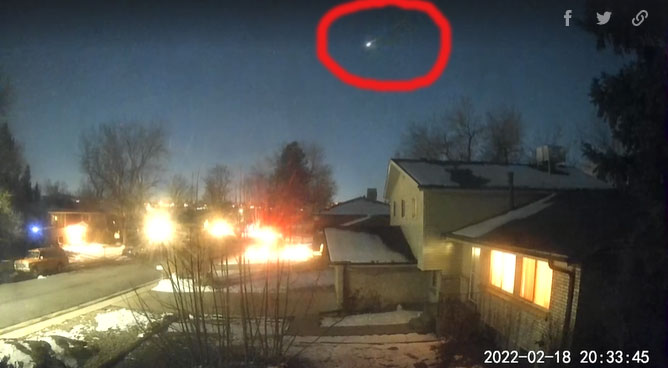A large meteor appeared over the state of Colorado on the night of February 18, exhibiting an unusual long trajectory and slow movement, with an estimated speed of 96,500 km/h.
Simon Foot, an amateur astronomer and photographer living in Arvada, Colorado, spotted the meteor while outside fiddling with a new astronomical camera. “I was almost looking straight up when I saw this object streaking across the sky from the left. It was moving surprisingly slowly. This is the most incredible meteor I have ever seen,” Foot recounted.
Foot noted that the meteor was flying almost directly south, with only a slight eastward tilt. “The meteor was bright white, and the debris breaking off from it burned with a light greenish color. Then, a flash of light appeared, and it disappeared,” he added.

Bright white meteor with burning debris.
Dozens of reports about the meteor on February 18 were submitted to the American Meteor Society (AMS), according to John Keller, director of the Fiske Planetarium.
Scientific instruments tracked the meteor’s trajectory from Steamboat, Colorado, to the state line with New Mexico, according to Chris Peterson, an astronomer at the Cloudbait Observatory. He remarked that a meteor with such a long flight path is quite unusual.
Peterson explained that the meteor might have bounced off the atmosphere and returned to space, or it could have completely burned up. It was moving at an unusually slow speed, estimated at around 96,500 km/h. Peterson believes that no fragments of the meteor reached the Earth’s surface.
“We call it a fireball – a larger and brighter meteor than usual. This time of year, fireballs appear quite frequently. They often move high in the sky during February, March, and April,” said Robert Lunsford, an expert at AMS.
The meteor on February 18 was not part of any meteor shower, according to Lunsford. “We call it a random event. It’s fortunate that it appeared in the evening when the weather wasn’t too cold, and some people were still outside to observe it,” he stated.


















































